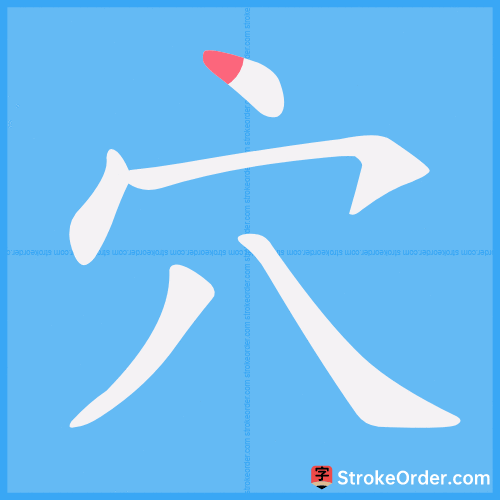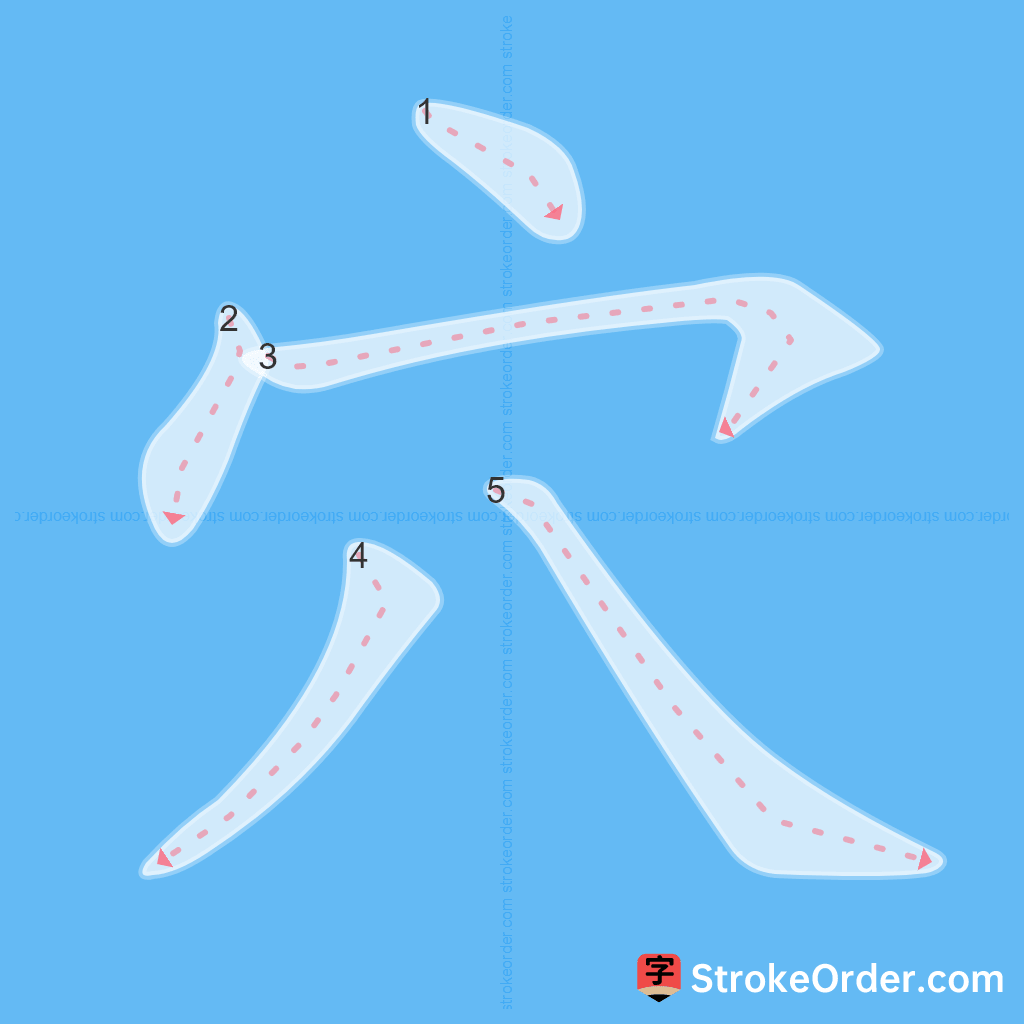穴 Stroke Order
Animated Stroke Order of 穴

Stroke Order Diagrams for 穴

Step-by-Step Handwriting Guide for 穴

Learn to Write Chinese Characters with Video Tutorials
Watch the video of writing the Chinese character "穴", learn the correct stroke order (笔顺) of the character "穴", and master the standard way of writing the character "穴".
Free Printable Handwriting Practice with Stroke Order: 穴
Printable Writing Practice Worksheet of "穴" in Portrait Orientation (Tian Zi Ge)

Printable Writing Practice Worksheet of "穴" in Landscape Orientation (Tian Zi Ge)

Information of 穴
Pinyin
xué、 xuàn
Radical
穴
Strokes
5 strokes
Usage
★★★★★
Definition
hole / cave
穴 [xué]
1. Cave; hole:孔~. 石~. ~居. ~隙. 龙潭虎~. (Examples: hole in the ground, rock cavity, dwelling hole, cave gap, the lair of a dragon or tiger)
2. Acupuncture point: 人体可以进行针灸的部位,多为神经末梢密集或较粗的神经干经过的地方. (Acupuncture points on the human body, mainly located where nerve endings are dense or thicker nerve bundles pass through)
3. Place occupied by performers in public: 旧艺人称在市场或广场上表演时所占的一块地方. (In ancient times, this referred to the space occupied by street performers when performing in markets or squares)
4. Surname: 姓. (A surname)
本义: 土窟窿,地洞 (Original meaning: earth hollow, cave)
造字法: 象形。小篆字形,上面是“宀”,表覆盖物;下面两边表示洞孔。 (Character formation: Pictographic. In the small seal script, the top part represents a covering while the lower sides represent holes.)
1. Same as the original meaning (cave; hole)
2. Coffin pit; open grave
3. Den (animal's home)
4. Lair (a place where enemies or traitors hide and take refuge)
5. Tunnel
6. Water course
7. Acupuncture point; acupoint, referring to locations on the human body used in acupuncture
引:
1. Noun: 土窟窿,地洞. "《说文》:穴,土室也。按,象嵌空之形,非八字。” (From "Shuo Wen": "穴, a soil chamber. Note: it is shaped like a hollow, not in the figure of '八'.")
3. "宋·王安石《游褒禅山记》:有穴窈然,入之甚寒。" (From Song Dynasty: Wang Anshi, "Travel to Baochan Mountain": "There is a cave, it is very cold upon entering.")
Examples:
洞穴 (cave or mountain cave), 穴人 (someone who collects stalactites in caves), 穴流 (water flow in a cave)
8. Live in caves
9. Dig; pierce
引: "《墨子·备穴》:穴土而入。" (From "Mozi": "Digging into the ground to enter.")
Examples: 穴矛 (tools for digging tunnels), 穴垣 (digging holes in walls), 穴胃 (piercing stomach walls)
名:
1. Human habitat in earthen rooms.
2. Cave, generally referring to pits or holes on the ground or in structures. 如: "洞穴", "幽穴", "岩穴".
3. Grave; burial pit 如: "墓穴”.
4. Nest; den 如: "巢穴", "兔穴".
5. In traditional Chinese medicine, key points where meridians converge, mainly dense nerve endings or thicker nerve fibers pass through 如: "穴道", "经穴".
动:
1. To dig or bore. "《墨子·备穴》:"每见古人登卫,又可喻我当攻者,善于挖掘而入,捆柱施火以坏吾城."
Input Method for 穴
Pinyin
xue2
Wubi
pwu
Cangjie
jc
Zhengma
wo
Four Corner
30802
Unicode
U+7a74
Same Pronunciation Characters